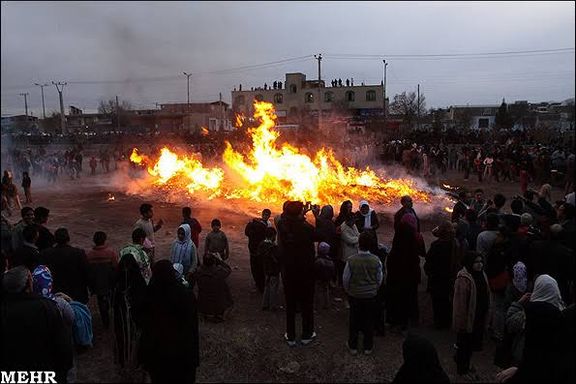Zoroastrian Fest Keeps Fire Of Protests Burning In Iran

Iranians marked an ancient tradition and protested against the government Monday night concurrent with the Sadeh festivities, an ancient Persian gala always frowned upon by the Islamic regime.

Iranians marked an ancient tradition and protested against the government Monday night concurrent with the Sadeh festivities, an ancient Persian gala always frowned upon by the Islamic regime.
In the past two weeks, grassroot groups had called for gatherings on the occasion of Sadeh festival that has its roots in Zoroastrianism and dates back to before the Achaemenid Empire for at least 3 millennia. The mid-winter festival was celebrated with grandeur and magnificence in ancient Persia to honor fire and to defeat the forces of darkness, frost, and cold. Iranians used the symbolism to protest against the oppressions of the clerical regime.
On Monday, in several cities across the country, people held gatherings around big bonfires and chanted slogans against the regime. The festival used to be celebrated mainly in cities such as Yazd and Kerman with a population of Zoroastrians, the followers of the pre-Islamic Iranian religion and one of the world's oldest organized faiths. However, this year the event was tied to the uprising that has been ongoing since mid-September, when 22-year-old Mahsa Amini was killed in custody of the hijab police.
According to social media videos, Sadeh celebrations were held in Tehran, Tabriz, Izeh, Ahvaz, Shiraz, Kerman, Sanandaj, some regions in Hormozgan province, Esfahan (Isfahan), Malayer, Mashhad, and many other cities and towns.

In several neighborhoods of Tehran, people set up fires, singing protest songs and chanting slogans against the regime and its ruler Ali Khamenei. In some cities, such as Izeh, people gathered at the graves of the protesters who were killed during the regime’s crackdown in rallies or in detention.
The ceremonies were held despite intensified pressure on the Zoroastrian associations to keep the event as small and limited as possible but people who gathered Monday night were mostly non-Zoroastrians.
Since the beginning of the current wave of protests, the regime has tried to avoid every possible gathering, including funeral services or wakes, as they tend to morph into antigovernment demonstrations. Among Zoroastrian Iranians, the Sadeh celebration is as important as Nowruz, which marks the new year.
In the Kurdish-majority city of Sanandaj, Sadeh celebrations were accompanied with rallies in protest against the arrest of two Sunni clerics in the city. Mamosta Loghman Amini and Mamosta Ebrahim Karimi Nanleh were arrested by the security forces earlier in the week. The two were the prayer imams of two Sunni mosques and had criticized the regime in support of the protests. Hengaw Organization for Human Rights, a Norway-based Kurdish rights group, said the two Sunni clerics were "arrested by the security forces on Marivan Road without a court order and taken to an unknown place."
The Islamic Republic has recently stepped up itscrackdown on Sunni clerics and Sunni majority areas, where the protests have been going on regularly and in large numbers, unlike some other parts of the country where protesters hold sporadic and small gatherings. In Sunni-majority province of Sistan-Baluchestan, Mowlavi Abdolmajid Moradzehi, a cleric close to the outspoken Sunni Imam of Zahedan, Mowlavi Abdolhamid, was also detained in recent days. Rallies by Iranian Sunni Muslims in the city of Galikash, in the northern Golestan province, are also being held regularly outside the home of the city’s Sunni cleric Mowlavi Mohammad Hossein Gorgij, the deposed Friday Imam of Azadshahr.